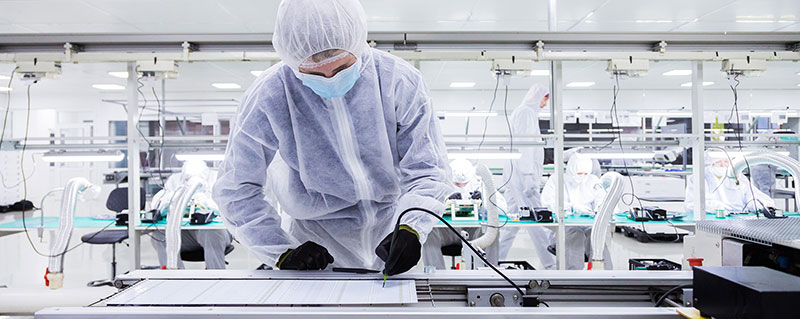Recommendations to help manufacturers survive the global pandemic and thrive when it’s over.
By Jerry Murphy, Sikich
During this unprecedented global pandemic, there are countless unknowns and uncertainties affecting manufacturers – and the situation is seemingly changing hour-by-hour. Though we’re all in uncharted territory, this is no time to adopt a wait-and-see posture. There are actions manufacturing business leaders should take today to ensure their organizations not only survive the current storm but also thrive when it ends. Here are five ways manufacturers can proactively protect and sustain their operations.

A manufacturer’s number one priority during this time must be the safety of its employees.
It’s important that manufacturers understand that their number one priority during this time must be the safety of their employees. Therefore, they must implement strict social-distancing protocols in their facilities, clean more frequently and thoroughly, consider putting barriers between workstations, and give employees gloves and masks to wear. Also, make clear to employees that they must stay home if sick and will not be punished for doing so. Manufacturers must go above and beyond to demonstrate sincere care for employees and their families during this crisis. These efforts will help a manufacturer retain a committed workforce through the crisis and get fully back up and running quickly, when it is over.
A global pandemic is not a run-of-the-mill recession. We don’t have models to help predict what comes next or when we’re in the recovery stage. Though your balance sheet may appear to be healthy today, that may change if customers stop placing orders or paying invoices in the weeks ahead. Do whatever you can right now to ensure you have cash in your pocket for the next several months.
The $2 trillion stimulus package President Trump signed into law in late March includes provisions that allow businesses to receive equity injections via loans from the Small Business Administration. Companies won’t have to repay some of these loans while others offer very low interest rates.
No matter a manufacturer’s current cash-flow situation, all eligible businesses should apply for these loans so they can continue to pay wages, benefits, utilities and rent during this time. However, manufacturers should move quickly, as some of these benefits are available on a “first come, first served” basis. There are also some payroll tax credits and incentives available to employers in 2020 that may provide cash-flow savings, but a company generally cannot claim these if it also participates in the loan programs.
Manufacturers can use the tax return and tax payment date extension as another opportunity to remain liquid by delaying 2019 tax payments until July 15. Beyond the filing deadline extension, it’s important to work with your tax adviser to identify other tax opportunities. For example, the same stimulus package noted above now allows companies to carry back net operating losses (NOLs) up to five years to recover taxes paid in prior years at higher tax rates. Previously, companies needed to carry these losses forward to future tax years. This carryback can generate a significant cash infusion for manufacturing operations at a crucial time. This NOL provision applies to losses generated in 2018, 2019, and 2020. Two other incentives for manufacturers to note: (1) those subject to the new interest expense limitations will see these limits softened in 2019 and 2020; and (2) any manufacturer making certain enhancements to its existing facility (known as “qualified improvement property,” or QIP) found welcome relief from Congress as these additions made since 2018 can now qualify for 100 percent bonus depreciation, and not a 39-year life.
With those who can work from home working from home, much of a manufacturer’s business is suddenly being conducted on a large scale via remote access to company networks. The organizations that have not put in place the proper protocols for remote access are scrambling and turning to quick workarounds. Some remote access protocols that companies are relying on to keep operations running today are vulnerable to cybercriminals, especially if the company has not made the latest security updates.
It’s a tough time to try to catch up, but, if you haven’t updated patches, implemented multifactor authentication for all remote access (including email), and installed up-to-date antivirus software on all workstations employees use from home, you need to start taking these steps, as soon as possible.
During these turbulent times, it’s more important than ever to communicate with everyone who touches your business in some way. Be as upfront as possible with employees about the state of the business, operational plans during the current crisis and steps you are taking to keep them safe.
Make sure you are regularly touching base with all your customers. Make it a point to have “virtual coffee” with these folks on a weekly basis so that you can discuss their current challenges or needs – and identify ways you can help. Now is also the time to flag any issues on your end (e.g., supply chain issues, production delays) that will impact customer orders. Customers will also appreciate hearing what you’re doing to protect your vendors and employees. If you don’t take the initiative to connect with your customers during this time, they may assume you’re closed for business.
We also recommend reaching out to your vendors to see if you can adjust your payment terms from 30 to 60 or even 90 days. Many vendors will accommodate, as they would rather receive payment in 90 days than not at all.
There are certainly many unknowns during this tumultuous time. During this pandemic, we believe that a bit of proactivity on the financial and cybersecurity fronts, met with honesty and integrity in communications with employees, customers and vendors, will win the day and be the difference between organizations that weather this storm and those that sink.

Jerry Murphy
About the Author
Jerry Murphy, CPA, CMA, CGMA, is partner-in-charge of Sikich’s manufacturing and distribution services team. Contact Jerry at jerry.murphy@sikich.com.
In this episode, I sat down with Beejan Giga, Director | Partner and Caleb Emerson, Senior Results Manager at Carpedia International. We discussed the insights behind their recent Industry Today article, “Thinking Three Moves Ahead” and together we explored how manufacturers can plan more strategically, align with their suppliers, and build the operational discipline needed to support intentional, sustainable growth. It was a conversation packed with practical perspectives on navigating a fast-changing industry landscape.